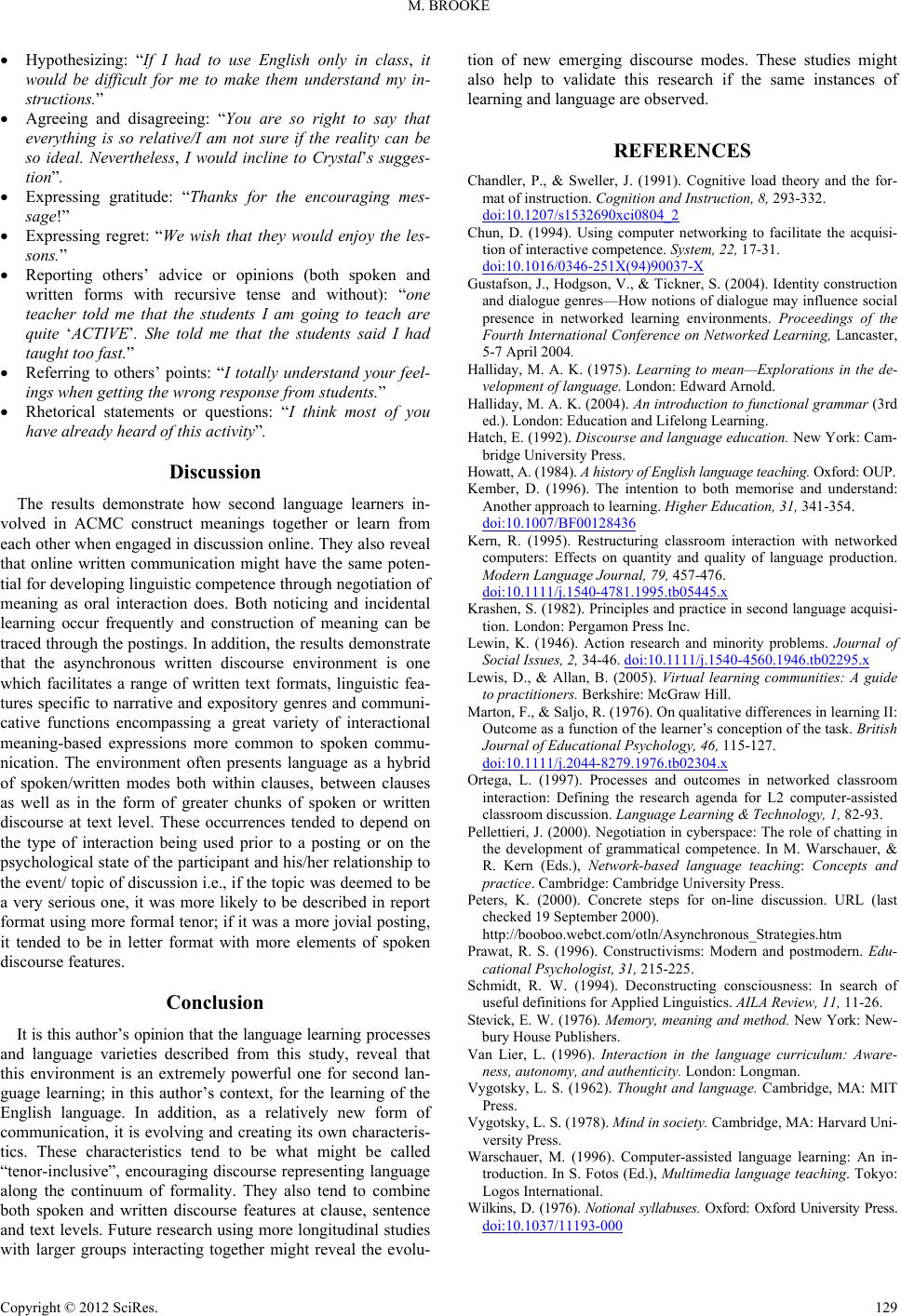
M. BROOKE
Copyright © 2012 SciRes. 129
Hypothesizing: “If I had to use English only in class, it
would be difficult for me to make them understand my in-
structions.”
Agreeing and disagreeing: “You are so right to say that
everything is so relative/I am not sure if the reality can be
so ideal. Nevertheless, I would incline to Crystal’s sugges-
tion”.
Expressing gratitude: “Thanks for the encouraging mes-
sage!”
Expressing regret: “We wish that they would enjoy the les-
sons.”
Reporting others’ advice or opinions (both spoken and
written forms with recursive tense and without): “one
teacher told me that the students I am going to teach are
quite ‘ACTIVE’. She told me that the students said I had
taught too fast.”
Referring to others’ points: “I totally understand your feel-
ings when getting the wrong response from students.”
Rhetorical statements or questions: “I think most of you
have already heard of this activity”.
Discussion
The results demonstrate how second language learners in-
volved in ACMC construct meanings together or learn from
each other when engaged in discussion online. They also reveal
that online written communication might have the same poten-
tial for developing linguistic competence through negotiation of
meaning as oral interaction does. Both noticing and incidental
learning occur frequently and construction of meaning can be
traced through the postings. In addition, the results demonstrate
that the asynchronous written discourse environment is one
which facilitates a range of written text formats, linguistic fea-
tures specific to narrative and expository genres and communi-
cative functions encompassing a great variety of interactional
meaning-based expressions more common to spoken commu-
nication. The environment often presents language as a hybrid
of spoken/written modes both within clauses, between clauses
as well as in the form of greater chunks of spoken or written
discourse at text level. These occurrences tended to depend on
the type of interaction being used prior to a posting or on the
psychological state of the participant and his/her relationship to
the event/ topic of discussion i.e., if the topic was deemed to be
a very serious one, it was more likely to be described in report
format using more formal tenor; if it was a more jovial posting,
it tended to be in letter format with more elements of spoken
discourse features.
Conclusion
It is this author’s opinion that the language lear nin g pr oce sses
and language varieties described from this study, reveal that
this environment is an extremely powerful one for second lan-
guage learning; in this author’s context, for the learning of the
English language. In addition, as a relatively new form of
communication, it is evolving and creating its own characteris-
tics. These characteristics tend to be what might be called
“tenor-inclusive”, encouraging discourse representing language
along the continuum of formality. They also tend to combine
both spoken and written discourse features at clause, sentence
and text levels. Future research using more longitudinal studies
with larger groups interacting together might reveal the evolu-
tion of new emerging discourse modes. These studies might
also help to validate this research if the same instances of
learning and language are observed.
REFERENCES
Chandler, P., & Sweller, J. (1991). Cognitive load theory and the for-
mat of instruction. Cognition and I ns truction, 8, 293-332.
doi:10.1207/s1532690xci0804_2
Chun, D. (1994). Using computer networking to facilitate the acquisi-
tion of interactive competence. System, 22, 17-31.
doi:10.1016/0346-251X(94)90037-X
Gustafson, J., Hodgson, V., & Tickner, S. (2004). Identity construction
and dialogue genres—How notions of dialogue may influence social
presence in networked learning environments. Proceedings of the
Fourth International Conference on Networked Learning, Lancaster,
5-7 April 2004.
Halliday, M. A. K. (1975). Learning to mean—Explorations in the de-
velopment of language. London: Edward Arnold.
Halliday, M. A. K. (2004). An introduction to functional grammar (3rd
ed.). London: Education and Lifelong L e a rning.
Hatch, E. (1992). Discourse and language education. New York: Cam-
bridge University Press.
Howatt, A. (1984). A history of English language teaching. Oxford: OUP.
Kember, D. (1996). The intention to both memorise and understand:
Another approach to learning. Higher Education, 31, 34 1-354.
doi:10.1007/BF00128436
Kern, R. (1995). Restructuring classroom interaction with networked
computers: Effects on quantity and quality of language production.
Modern Language Journal, 79, 457-476.
doi:10.1111/j.1540-4781.1995.tb05445.x
Krashen, S. (1982). Principles and practice in second language acquisi-
tion. London: Per ga mon Press Inc.
Lewin, K. (1946). Action research and minority problems. Journal of
Social Issues, 2, 34-46. doi:10.1111/j.1540-4560.1946.tb02295.x
Lewis, D., & Allan, B. (2005). Virtual learning communities: A guide
to practitioners. Berkshire: McGraw Hill.
Marton, F., & Saljo, R. (1976). On qualitative differences in learning II:
Outcome as a function of the learner’s conception of the task. British
Journal of Educational Psychology, 46, 115-127.
doi:10.1111/j.2044-8279.1976.tb02304.x
Ortega, L. (1997). Processes and outcomes in networked classroom
interaction: Defining the research agenda for L2 computer-assisted
classroom discussion. Langua ge Le a r ni n g & Technology, 1, 82-93.
Pellettieri, J. (2000). Negotiation in cyberspace: The role of chatting in
the development of grammatical competence. In M. Warschauer, &
R. Kern (Eds.), Network-based language teaching: Concepts and
practice. Cambridge: Cambridge University Press.
Peters, K. (2000). Concrete steps for on-line discussion. URL (last
checked 19 September 2000).
http://booboo.webct.com/otln/Asynchronous_Strategies.htm
Prawat, R. S. (1996). Constructivisms: Modern and postmodern. Edu-
cational Psychologist, 31, 215-225.
Schmidt, R. W. (1994). Deconstructing consciousness: In search of
useful definitions for A p p li e d L i ng u i st i c s. AILA Review, 11, 11-26.
Stevick, E. W. (1976). Memory, meaning and method. New York: New-
bury House Publishers.
Van Lier, L. (1996). Interaction in the language curriculum: Aware-
ness, autonomy, and authenticity. London: Longman.
Vygotsky, L. S. (1962). Thought and language. Cambridge, MA: MIT
Press.
Vygotsky, L. S. (1978). Mind in society. Cambridge, MA: Harvard Uni-
versity Press.
Warschauer, M. (1996). Computer-assisted language learning: An in-
troduction. In S. Fotos (Ed.), Multimedia language teaching. Tokyo:
Logos International.
Wilkins, D. (1976). Notional syllabuses. Oxford: Oxford University Press.
doi:10.1037/11193-000